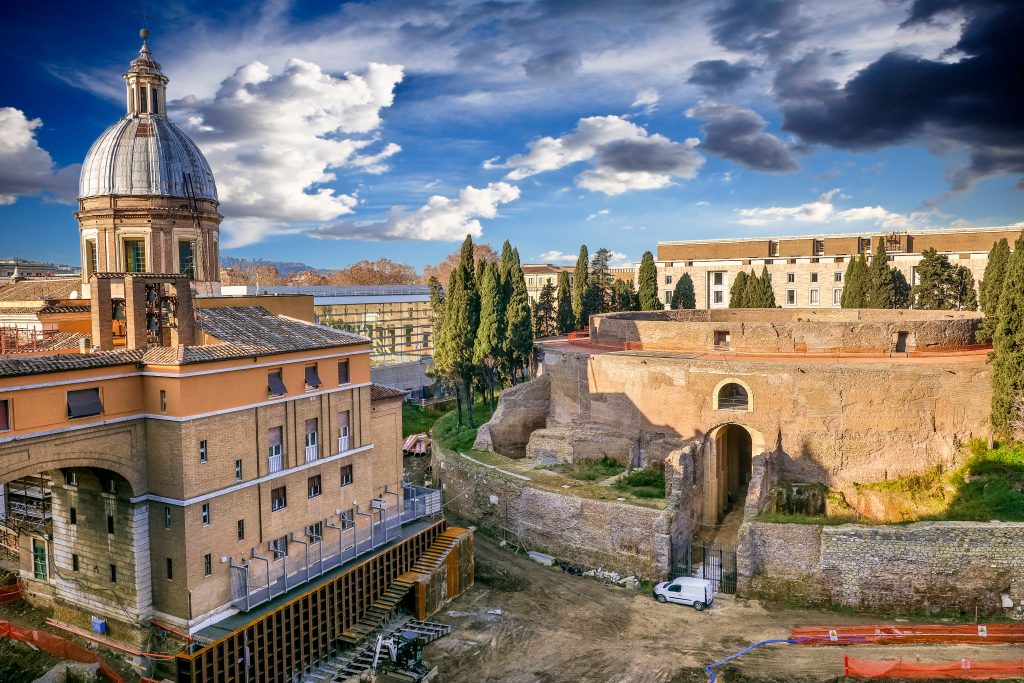Based on his historic 40-year reign (27 BC-14AD) as the first Emperor of the Roman Empire, Augustus is widely considered Rome’s greatest and most transformative Emperor. Augustus’ legacy began when he was still known as Octavian – when Julius Caesar was assassinated, his will named Augustus as his adopted son and heir. Though the assassination was meant to prevent a future emperor, Augustus made his mark on Rome by ending the civil war, expanding the empire, ushering in two centuries of Pax Romana, and transforming Rome – part of which included a new Senate House and the city’s first baths. As Augustus would say, “I found Rome a city of bricks and left it a city of marble”.
Augustus died in 14AD. Having been the most powerful man in the world at that time, he had planned his funeral in advance. During his 30s, he had his tomb built in Rome so that it be enjoyed during his lifetime. Once a gleaming symbol of world power, when Rome was conquered in 410, the Visigoths destroyed the structure and as the capital was left in ruin, the mausoleum became overgrown and unrecognizable by the end of the 10th century.
Augustus is said to have been inspired by the mausoleum of Alexander the Great in Alexandria, Egypt. Although Augustus Mausoleum is the largest circular funerary monument in the world, it was left in ruinous condition until the full restoration began in October 2016. The great tomb of Augustus is the largest in the Roman world. It was only matched by Hadrian’s Mausoleum, located on the other side of the Tiber River, the Castel Sant Angelo (open to the public).
Augustus Mausoleum Historical Timeline
Like many ancient sites and monuments that have survived intact or partially intact, the Mausoleum of Augustus has had an interesting history. It was not simply a funerary tomb that decayed over time only to be salvaged by antiquarians and archaeologists. It was even used as a concert venue!
28 BC Construction started on the mausoleum, and until 217 AD the ashes of the Julio-Claudio dynasty Emperors (excluding Nero) and their family were placed in the inner chambers.
12th century The Colonna princes fortified the structure, much like Hadrian’s Mausoleum was turned into a fortress at this time.
1241 Pope Gregory IX expelled the Colonna family and destroyed the fortress.
18th century The Soderini family bought the site and created an ornate garden within the enclosure. Subsequently, it was used to stage bullfights, then for theatrical and circus performances.
1907- 1936 The inner enclosure was converted into a concert hall, known as the Augusteo it seated around 3,500 people.
Mussolini put an end to the concerts, the last one performed on 13 May 1936. He rather fancied it for a tomb for himself as part of his regeneration of the Piazza Augusto Imperatore. This never happened.
Over the years, the mausoleum has been a fortress, garden, bullring, vineyard, circus, concert hall, and most recently an archaeological site during the 20th century, until the war put a stop to excavations. In an effort to conserve this historic landmark, Gruppo TIM, an Italian telecoms company invested €12m towards its renovation. The investment paid off as the mausoleum was opened to the public in early March 2021, for the first time since 2007. Officially reopened on Mar 1, 2021, tickets to the Mausoleum are already sold out until July 2021!
Upon entering the restored entryway that towers over guests, you will find a circular structure echoing that of the Colosseum and Pantheon. At the central court is a cylindrical structure that likely once contained the ashes of Augustus. Several barrel-vaulted corridors surround the center and it is easy to imagine how ornate they must have been, as the tomb was once decorated with statues, reliefs, and inscriptions on marble plaques during the peak of Rome and Augustus’ reign.
Being a big fan of Ancient Roman history in general and the reign of Augustus in particular, please note my three favorite books on Roman history (also available via Audible!):
Augustus by Adrian Goldsworthy
SPQR: A History of Ancient Rome by Mary Beard
Ten Ceasars by Barry Strauss
